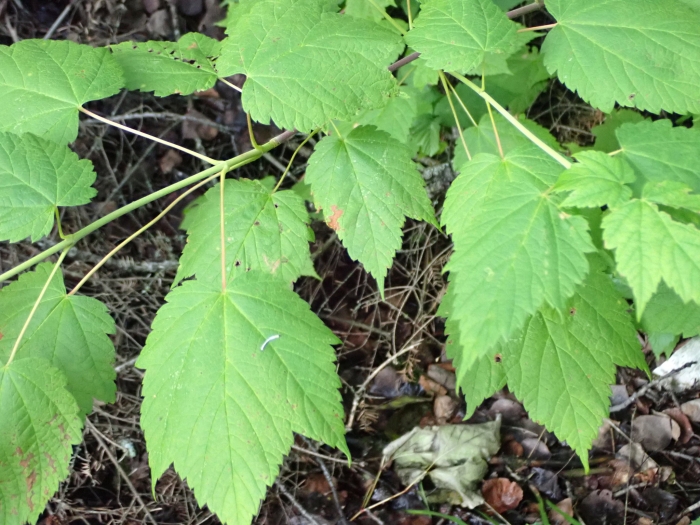Mountain Maple
(Acer spicatum)
Mountain Maple (Acer spicatum)
/
/

Mary Krieger
CC BY 4.0
Image By:
Mary Krieger
Recorded By:
Copyright:
CC BY 4.0
Copyright Notice:
Photo by: Mary Krieger | License Type: CC BY 4.0 | License URL: http://creativecommons.org/licenses/by/4.0/ | Rights Holder: Mary Krieger | Publisher: iNaturalist | Date Created: 2019-07-21T08:19:23-07:00 |





















































Estimated Native Range
Summary
Acer spicatum, commonly known as Mountain Maple, is a deciduous shrub or small tree native to cool, moist, deciduous, and mixed forests in the Eastern United States and Canada, particularly thriving in forest understories and along stream banks. It typically grows to 3–8 m (10–25 ft) tall with a spreading crown, a short trunk, and slender branches. The leaves are opposite, with a broad, toothed margin and a pointed tip, turning brilliant yellow to red in the fall. The bark is thin, dull gray-brown, and smooth, becoming slightly scaly with age. In late spring to early summer, small, showy clusters of yellowish-green flowers appear, followed by the distinctive paired reddish samaras, 2–3 cm (3⁄4–1+1⁄4 in) long, maturing in late summer to early autumn.
Mountain Maple is valued for its bright fall foliage and adaptability to a range of light conditions, making it suitable for understory plantings, naturalized areas, and as a secondary canopy layer in larger landscapes. It is also used for erosion control due to its fibrous root system. This species prefers cool, moist conditions and can tolerate a variety of soil types with medium drainage, though it does best in slightly acidic to neutral soils. While it can grow in full sun to full shade, partial shade is ideal for optimal growth and foliage color. Gardeners should be aware that it may be susceptible to leaf spot diseases and aphids, but these are generally not serious problems.CC BY-SA 4.0
Mountain Maple is valued for its bright fall foliage and adaptability to a range of light conditions, making it suitable for understory plantings, naturalized areas, and as a secondary canopy layer in larger landscapes. It is also used for erosion control due to its fibrous root system. This species prefers cool, moist conditions and can tolerate a variety of soil types with medium drainage, though it does best in slightly acidic to neutral soils. While it can grow in full sun to full shade, partial shade is ideal for optimal growth and foliage color. Gardeners should be aware that it may be susceptible to leaf spot diseases and aphids, but these are generally not serious problems.CC BY-SA 4.0
Plant Description
- Plant Type: Tree, Shrub
- Height: 15-30 feet
- Width: 6-20 feet
- Growth Rate: Moderate
- Flower Color: N/A
- Flowering Season: Spring
- Leaf Retention: Deciduous
Growth Requirements
- Sun: Part Shade, Full Sun, Full Shade
- Water: Medium, High
- Drainage: Medium
Common Uses
Bank Stabilization, Bee Garden, Bird Garden, Butterfly Garden, Deer Resistant, Edible*Disclaimer: Easyscape's listed plant edibility is for informational use. Always verify the safety and proper identification of any plant before consumption., Erosion Control, Rabbit Resistant, Water Garden
Natural Habitat
Cool, moist, deciduous, and mixed forests, particularly forest understories and along stream banks
Other Names
Common Names: Moose Maple, White Maple, Dwarf Maple, Plaine Bleue, Plaine Bâtarde, Érable Bâtard, Érable À Épis, Axlönn
Scientific Names: , Acer spicatum, Acer parviflorum, Acer rugosum, Acer pumilum, Acer spicatum f. roseocarpum, Acer spicatum f. rugosum,
GBIF Accepted Name: Acer spicatum Lam.